Top 10 ESL kids lesson plan routines for 8s and over
What are some tips for regular items to add to your lessons for 8s and over?
In this article we will provide 10 key elements that can be included in your lesson plans on a regular basis for the your ESL students.
Having a familiar structure to your lesson helps to build a routine which covers all the key elements for learning and reviewing English. Here are 10 key elements that can be included in your lesson plans on a regular basis for students 8-years and up.
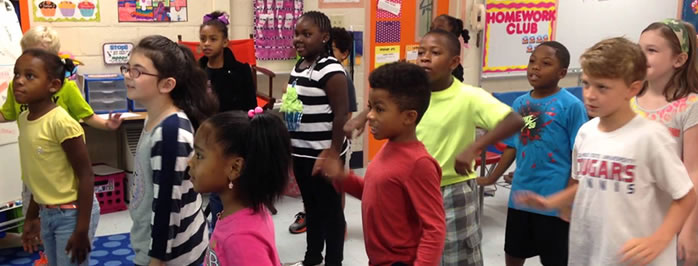
1. Greetings (warm-up section)
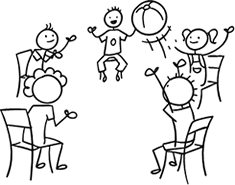
Sit everyone in a circle around you and throw (or roll) a ball to each student randomly. As you do so, ask questions, starting from the simple (What’s your name?, How are you?) to more involved questions (Where do you live?, What is your [hide_on_uk]favorite[/hide_on_uk][hide_on_us]favourite[/hide_on_us] food, Do you like Superman?, Can you fly?, etc.). You can review questions from previous lessons and introduce new questions.
Try to introduce one or two new questions a month – the first time they are introduced ask everybody the question, then always review in the preceding lessons.
2. Review the day, date and month (warm-up section)
After you have taught the days and months lesson, you can include this section in every class. You’ll need a large calendar for this, ideally with the days and months written in English.
Sit everyone down facing you and turn the page of the calendar to January. Ask, “Which month is this?” and have everyone shout out “January!”. Then ask, “Is it January now”? Elicit “Yes” or “No” depending on the month you are in. Keep turning the pages and eliciting months until you reach your current month.
Next ask, “What day is it today?”, pointing to the days at the top of the page. Get everyone to shout out the day.
After that, point down the column of dates and ask, “What is the date today?”, and elicit the correct date.
Finally, invite a student to come up to the calendar and stick a star or sticker onto the correct date.
Additionally, you can sing The days of the week song or the Months march song.
3. Talk about the weather (warm-up section)
After you have taught the weather lesson, you can include this section in every class.
You’ll need to prepare a weather board. Check out our video below on creating your own weather board:

Before class, prepare a piece of cardboard and cover it with blue felt (to represent the sky). Write at the top of the board, in large letters, “How’s the weather today?”. Below that write “Today it’s”. Cut out weather pictures (such as from our weather flashcards) and stick some velcro on the back of each picture. Arrange the weather pictures around the edge of the board and put the board on the wall of your classroom. You can now use this weather board at the beginning of every lesson.
In class, start by singing The weather song. Sing the song together doing all of the gestures.
Next, look outside. Get everyone to look outside by asking, “How’s the weather? Look outside”. Elicit the weather for that day.
Finally, we’ll put the weather pictures on the weather board. Invite some students to come up and put the weather pictures on the board. Make sure these students say the word as they put the card on the board.
4. Homework check / Assign homework (warm-up and wrap-up section)
In the beginning section of the lesson, you can check your student’s homework. Ask each student some questions about their homework worksheet, give lots of praise, and then put a mark on the homework sheet (e.g. a sticker, a stamp or draw a smiley face). Finally, tell your students to put their homework back into their bags.
At the end of the lesson you will need to set homework – a worksheet is a good option. Hold up the homework worksheet and model how to do it. Give out the worksheets and say, “Put your homework in your bags”.
5. Play the “Can you” challenge (warm-up section)
This is a fun activity to do each lesson – it gets everyone up and moving around and is a good signal for the start of the main part of the lesson.
Ask your students “Can you …?” questions, such as,
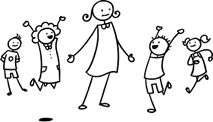
- Can you jump 10 times in 10 seconds?
- Can you say the alphabet backwards?
- Can you name three things in this room that begin with the letter “M”?
- Can you pat someone on the back?
- Can you find a black pen?
- etc.
6. Notice board (warm-up section)
This is a great way to encourage students to use their reading and writing skills. Put a cork notice board up in the classroom and put new notices on it each class. Notices can include birthday announcements, homework setting, words of praise or encouragement to individual students, your thoughts on different issues (e.g. a new pop song or movie), lost & found items, up and coming events and so on. Also, encourage your students to reply to your notices and add their own notices.
7. Alphabet scrap books (warm-up / review section)
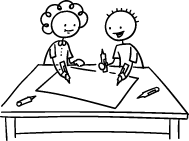
You’ll need a big scrap book for the class, or if you have a lot of students, one for each group of 4-8 students. In the first lesson, students will prepare and decorate the book – put a letter of the alphabet in the corner of each double page (upper and lower-case), so you have a double-page for each letter of the alphabet.
For homework each week, assign a topic, such as the kitchen, weather, stationary, [hide_on_uk]movies[/hide_on_uk][hide_on_us]films[/hide_on_us], animals, etc. Students have to find 3 (small) pictures of items in that category and bring them to class (they can cut out of a magazine, for instance). In class, students glue the pictures onto the page with a first letter of the item (e.g. a frying pan will go on the “F” page) and write the word underneath the picture.
Over time, the book will grow as more and more picture words are added.
8. Review time (warm-up / review section)
Always include a review section in your lesson. You can review the previous lesson and also language from any lessons from the past. The key is to make this section fast and fun!
Here are some things to review:
- do a vocabulary review game, such as hangman, I spy, etc.
- do a couple of games and activities from a previous lesson, especially ones that went down well!
- review a story – again, you can read a classroom reader from a previous lesson. If you display all of the readers you have read, students can choose what to review.
9. Clean up (wrap-up section)
Always have your students help to clean up: tidy away classroom objects and stationery, put their chairs neatly under their desks, clean the board, put their things in their bags and put on their coats. At first, you will need to show everyone what to do, but in no time at all they will be able to do this at the drop of a hat.
10. Line up – quick check and goodbye (wrap-up section)
When it is time to leave the class make sure everything is put away and the students have gathered up their belongings. Have them line up at the door and place yourself between the door and the students. For each student, check one new word, phrase or question (e.g. hold up a flashcard and ask, “What’s this?”). When they answer correctly, say goodbye and let them leave. If they get the question wrong, they go to the back of the line to try again.
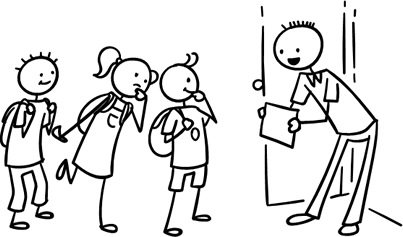
Do you have any ideas for routines not mentioned in our list above? If so, please let us know in the comments below!
More ESL articles »
General articles
- 6 different types of ESL learners and how to teach them
- Dealing with bad [hide_on_uk]behavior[/hide_on_uk][hide_on_us]behaviour[/hide_on_us] in an ESL kids classroom
- Using graded readers in the ESL kids classroom
- Word lists: lists of the most commonly used English vocabulary
Top 10 lists
- Top 10 alphabet teaching tips for ESL kids teachers
- Top 10 ESL flashcard exciting games & activities
- Top 10 flashcard simple games & activities
- Top 10 ESL kids lesson plan routines for 7s and under
- Top 10 ESL kids lesson plan routines for 8s and over
- Top 10 ESL listening activities (without a CD)
- Top 10 supplies ands tools for an ESL kids classroom
- Top 10 tips for teaching English to toddlers
- Top 10 tips for using classroom readers in ESL kids lessons
- Top 10 worksheet time activities for ESL teachers and students
Holidays articles

